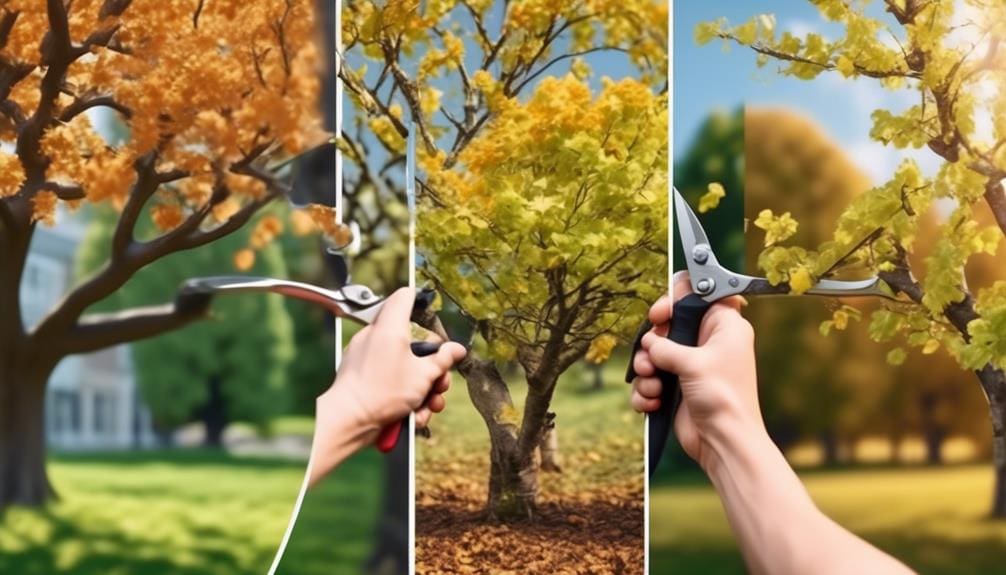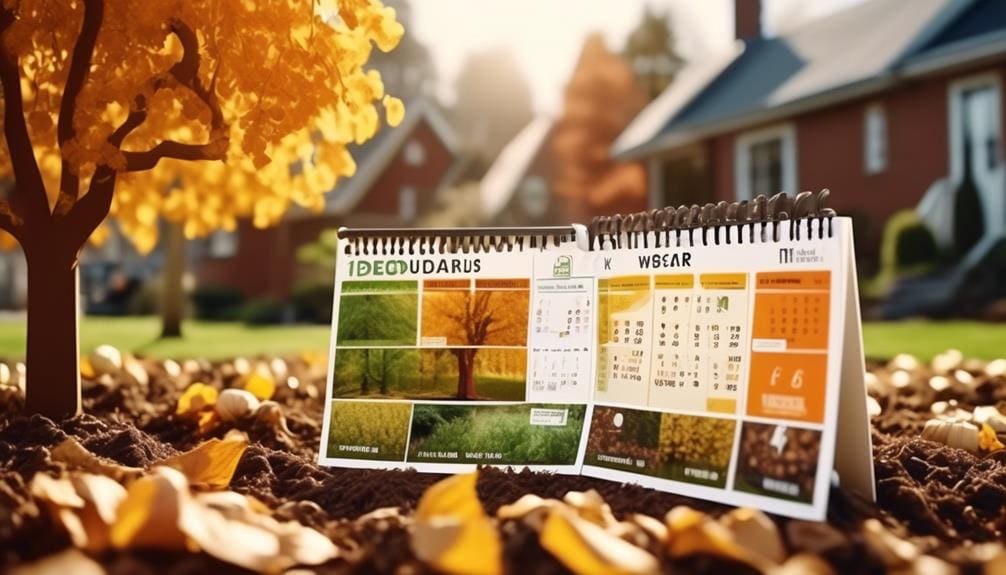Safety and Regulations
Prune Smart: Deciduous Tree Timetable
Nearly 80% of a tree’s pruning needs occur in the first 20 years of its life, which is why we’re focusing our expertise on creating a schedule that aligns with the unique growth cycles of deciduous trees.
We’ve gathered the latest arboricultural practices to help you understand the critical timing and techniques for pruning, ensuring your trees reach their full potential in both health and aesthetics.
Our guide not only simplifies the complexity of the task but also equips you with the knowledge to make informed decisions.
Stick with us as we uncover the secrets to maintaining the vigor and beauty of your trees through the seasons, and prepare to transform your landscape with precision and care.
Key Takeaways
- Pruning during the dormant period before spring growth is beneficial for deciduous trees as it minimizes stress and maximizes new growth potential.
- Pruning during dormancy allows for a clear view of the tree’s branch structure and encourages the development of strong flower buds.
- Different tree species have optimal trimming seasons, and pruning activities should be planned accordingly to avoid sap bleeding and diseases like silver leaf disease.
- Pruning methods should be tailored to the tree’s species, age, and desired outcome, aiming to retain the tree’s natural form. Safety gear and equipment sterilization are essential during pruning for safety and tree health. Responsible waste management should be practiced after tree maintenance activities.
Understanding Growth Cycles
Deciduous trees undergo distinct growth cycles annually, characterized by phases of dormancy, budding, leaf expansion, and senescence. We recognize the importance of timing when it comes to pruning these trees.
The optimal moment to prune deciduous trees is during the dormant period, before the spring growth initiates. This timing is critical as it minimizes stress on the trees and maximizes their potential for robust new growth.
Pruning during dormancy allows for a clear view of the tree’s branch structure, facilitating selective removal of branches that may hinder the tree’s vigor. We strategically remove branches to encourage the development of strong flower buds, ensuring a splendid display.
Each tree species has its unique growth pattern, and we must tailor our pruning techniques accordingly to respect their biological rhythms and enhance their natural form.
Optimal Trimming Seasons
To ensure the vitality and structural integrity of deciduous trees, we meticulously plan our pruning activities to coincide with each species’ optimal trimming season. We avoid pruning walnut and birch in winter to prevent sap bleeding. Our precise timing also circumvents silver leaf disease.
During the dormant season, specifically late winter or early spring, we prune to remove weak, vigorous, and diseased growth. The pruning cuts are strategic, targeting dead or damaged branches, and are crucial for the tree’s health.
Alder and ash trees require care in late spring to summer, while elm trees need triennial surgery and annual minor pruning. Consulting with an arborist is paramount to determine the species-specific timing, ensuring proper pruning.
Pruning trees is both beneficial and liberating for the property owner.
Pruning Methods Explained


Understanding the various pruning techniques is critical for maintaining the health and structure of deciduous trees. Each method must be tailored to the tree’s species, age, and desired outcome. Pruning fruit trees, for instance, often requires cutting back to bolster fruit production and enhance light penetration. We ensure to cut outside the branch collar to foster proper healing and avoid disease transmission.
To maintain a strong tree structure, it’s imperative to remove any dead or diseased branches, which pruning helps accomplish. This not only prevents the spread of decay fungi but also deters infestation by destructive insects.
When we prune trees, our meticulous approach is to retain the tree’s natural form. We consult arborists to refine our pruning objectives, safeguarding the vigor and aesthetics of each specimen.
Safety and Equipment Essentials
When pruning deciduous trees, it’s crucial to prioritize safety by donning appropriate protective gear, including gloves, safety glasses, and a hard hat, to mitigate the risk of injury from falling debris and sharp tools. We ensure our pruning tools are sharp and clean, facilitating precise cuts that minimize damage to the trees. This is particularly pertinent when it’s the best time to prune, which is generally in late winter or early spring before the growth flush.
Before we commence any tree service work, we meticulously inspect the site for potential hazards. Power lines, unstable branches, and uneven terrain demand our vigilance. We make sure to sterilize our equipment to prevent disease transmission, adhering to species-specific pruning techniques. This isn’t just a good time to prune, but also the right way to promote tree health and safety.
Responsible Waste Management


Having addressed the essential safety measures and pruning techniques, we now turn our attention to the equally important aspect of responsible waste management following tree maintenance activities.
When we trim trees, especially during fall pruning when trees shed their leaves, the accumulation of pruned right branches and other debris demands our conscientious disposal.
Recycling these young branches and dying branches isn’t only sustainable but enhances our community’s environmental health. We strongly advocate composting to transform tree trimming waste into valuable organic matter, enriching soil structure and vitality.
Certified Arborists can provide expert guidance on proper waste disposal, ensuring that trees can be pruned without detriment to our shared ecosystem. Let’s commit to avoiding the burning of tree waste to protect air quality, considering donation options for reusable materials.
Conclusion
In concluding, we’ve demystified the intricacies of deciduous tree pruning. Armed with our tailored timetable, you’re now equipped to optimize growth and health through strategic trimming.
Embrace our methods, prioritize safety with the right equipment, and adopt eco-friendly waste practices. Together, we’ll cultivate thriving landscapes that reflect our shared dedication to arboriculture excellence.
Let’s commit to these guidelines and ensure our trees’ vitality for seasons to come.


Hello there! I’m Logan Foster, the green-thumbed social media marketer behind the vibrant world of 1800TreeGuy.com. With roots firmly planted in arboriculture, I’ve branched out to help clients cultivate their dream outdoor spaces, one leafy canopy at a time. My knack for nurturing nature is more than a profession—it’s a way of life.
When I’m not talking trees and teaching the art of arboreal care, you can find me cheering on the Bulldogs—my alma mater’s pride and my forever team. My environmental studies there didn’t just teach me about ecosystems; they instilled a lifelong passion for protecting our planet.
Off the clock, I’m an adventurer at heart. Whether it’s trekking the Appalachian trails, pedaling down a mountain path, or crafting guides to share the wonders of the wild, I’m happiest with soil under my nails and the sun on my face. And let’s not forget Yoda, my pug sidekick. He may not have mastered the art of stillness, but his joyful grins are my daily dose of happiness.
I’m all about making connections—between people and the great outdoors and between my clients and their ideal landscape visions. My approach is personal; every tree has a story, and every garden reflects its caretaker.
If you want to green your scene or share in my outdoor escapades, give me a shout on Instagram or Facebook. Let’s cultivate a conversation and grow a community rooted in a love for the lush life.







